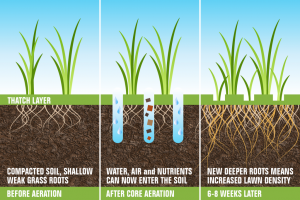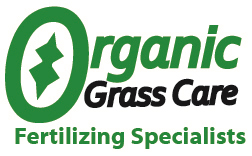LAWN AERATING
How is aerating achieved?
Aerating can be done several ways.
Microbial Aeration is the best process to achieve deeper and thicker roots. Core aerating uses hollow tines or forks to remove a plug of the turf. The hole provides a seed bed and an entry point for the nutrients, air and water, as well as proving a seed bed for overseeding. The plug is usually left on the surface. In doing so, the plugs organically break down the build up of thatch.  Aerating can also be done with solid tines. No core is removed so topdressing and overseeding are slightly less effective but the surface is still penetrated allowing for improved air, water and nutrients uptake and some relief of compaction.
Aerating can also be done with solid tines. No core is removed so topdressing and overseeding are slightly less effective but the surface is still penetrated allowing for improved air, water and nutrients uptake and some relief of compaction.
Aerating is usually accomplished with a walk behind machine with hollow or solid tines mounted on a drum which propels the machine forward, poking holes along the way. Aerating can also be done with simple tools like a pitchfork, a pitchfork-like tool with hollow tines, or even sandals equipped with long spikes.
Microbial Aeration.
Microbial aeration is 100% organic. There is no longer the need to mark utilities, irrigation, or invisible fences. The organic granular product, will penetrate 6″-12″. While other processes penetrate 1″-4″. In addition, there will be no more ripping of the turf or plugs on the top of the lawns. As the granual penetrates deeper, the roots of the grass follow to feed. This process helps establish healthier and thicker lawns.
When and how often should I aerate?
Aerating is most effective when done every spring and fall, especially if it is done in conjunction with overseeding and fertilizing as part of a complete lawn care program.
Why should I aerate?
When aerating is done in spring and fall, it allows the grass roots to grow deeper. With the roots growing deeper, the grass becomes harder. During the HOT months, the grass has a better chance of surviving and not drying out, due to the lack of water.

